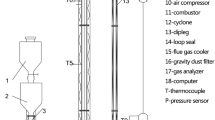Abstract
In recent years, the Chinese waste-to-energy (WTE) industry is growing at the rate of about thirty new plants each year. The municipal solid waste (MSW) fuel has a low heating value of 4–7 MJ/kg, in comparison to about 11 MJ/kg in U.S. and 8–11 MJ/kg in EU. Combustion of the low heating value fuel on a moving grate (MG), the dominant combustion technology worldwide, is difficult to control and measures have to be taken to remove some moisture prior to combustion. For this and other reasons, an alternative technology, the circulating fluid bed (CFB) has been implemented in China. This paper is a comparative study of the two technologies and was carried out by Columbia University and two senior engineers, representing the MG and CFB technologies of China. Data were derived from industrial operating plants and from the literature. The fuel to MG furnaces is as-received MSW, while the MSW to CFB reactors is pre-shredded using high-torque low-speed shredders. The availability of MG plants, over a 1-year period, is 90% + , while that of CFB facilities is 80% +. Also, the in-plant electricity consumption of MG plants is slightly lower than the consumption of CFB plants. The MG furnace is less compact, than that of a CFB combustion chamber, with a heat flux range from 0.5 to 0.6 MW/m2 of grate surface area, while that of CFB furnace was about 1.7 MW/m2 of furnace cross-section. The bottom ash in a MG process is typically wet-discharged and the recovery of metals is less efficient. A drawback of the CFB process is that the fly ash generated is 5–10% of the weight of MSW combusted, as compared to 1–3% for moving grate plants in China.





Similar content being viewed by others
Change history
27 August 2021
A Correction to this paper has been published: https://doi.org/10.1007/s42768-021-00078-9
References
World Bank Data Centre. 2016. http://databank.worldbank.org/data/home.aspx. Accessed Oct 2016.
Mian MM, Zeng X, Nasry ANB, et al. Municipal solid waste management in China: a comparative analysis. J Mater Cycles Waste Manag. 2016;19:1127–35.
United Nations Statistic Division, Demographic Yearbook. 2016. http://unstats.un.org/unsd/demographic/products/dyb/default.htm. Accessed Oct 2016.
Nixon JD, Wright DG, Dey PK, et al. A comparative assessment of waste incinerators in the UK. Waste Manag. 2013;33:2234–44.
Huang Q, Chi Y, Themelis NJ. A rapidly emerging WTE technology: circulating fluid bed combustion. In: Conference proceedings, international thermal treatment technologies (IT3) 33rd, Air and Waste Management Association, San Antonio; 2013.
ISWA. The International Solid Waste Association, Waste-to-Energy State-of-the-Art-Report, Statistics 6th Edition, August 2012, Revision November; 2013.
National Bureau of Statistics of China. http://data.stats.gov.cn/easyquery.htm?cn=C01. Accessed Sept 2019.
Ministry of Environmental Protection of China. Report on waste management. 2018. http://english.sepa.gov.cn/Resources/Reports/. Accessed Oct 2018.
Koornneef J, Junginger M, Faaij A. Development of fluidized bed combustion—an overview of trends, performance and cost. Prog Energy Combust Sci. 2006;33:19–55.
Leckner B. Process aspects in combustion and gasification Waste-to-Energy (WtE) units. Waste Manag. 2015;37:13–25.
Michaels T, Krishnan K. Energy Recovery Council, 2018 Directory of Waste-to-Energy Plants. http://energyrecoverycouncil.org/wp-content/uploads/2019/10/ERC-2018-directory.pdf
Themelis NJ, Barriga ME, Estevez P, et al. Inter-American Development Bank, Guidebook for the Application of Waste-to-Energy Technologies in Latin America and the Carribean. Earth Engineering Center, Columbia University; 2013.
Zheng L, Song J, Li C, et al. Preferential policies promote municipal solid waste (MSW) to energy in China: current status and prospects. Renew Sustain Energy Rev. 2014;36:135–48.
Van Caneghem J, Brems A, Lievens P, et al. Fluidized bed waste incinerators: design, operational and environmental issues. Prog Energy Combust Sci. 2012;38:551–82.
Granatstein DL. Technoeconomic assessment of fluidized bed combustors as municipal solid waste incinerators: a summary of six case studies, CANMET Energy Technology Centre (CETC), IEA bioenergy task 36, 2004.
McDougall FR, White PR, Frankle M, et al. Integrated solid waste management: a life cycle inventory. New York: Wiley; 2001. p. 303 (ISBN: 978-0-632-05889-1).
Eurostat database. ‘Municipal waste generation and treatment, by treatment method’. http://ec.europa.eu/eurostat/web/waste/municipal-waste-generation-and-treatment-by-treatment-method. Accessed Oct 2016.
US EPA statistics. https://www.epa.gov/smm/advancing-sustainable-materials-management-facts-and-figures. Accessed Oct 2018
Zhou H, Meng AH, Long YQ, et al. An overview of characteristics of municipal solid waste fuel in China: physical, chemical composition and heating value. Renew Sustain Energy Rev. 2014;36:107–22.
Fitzgerald G. Technical and Economic Analysis of Pre-Shredding Municipal Solid Wastes Prior to Disposal, MS-Thesis, Columbia University, 2009. http://www.seas.columbia.edu/earth/wtert/sofos/Garrett_Fitzgerald_MS_Thesis.pdf. Accessed 12 Sept 2019.
Morin O. Technical and environmental comparison of circulating fluidized bed (CFB) and moving grate reactors. MS Thesis. Columbia University. 2015. http://www.seas.columbia.edu/earth/wtert/sofos/Morin_Thesis.pdf.
Albores P, Petridis K, Dey PK. Analyzing efficiency of waste to energy systems: using data envelopment analysis in municipal solid waste management. Procedia Environ Sci. 2016;35:265–78.
Sharobem TT. Mitigation of high temperature corrosion in waste-to-energy power plants. Ph.D. Thesis, Columbia University. 2016. http://www.seas.columbia.edu/earth/wtert/sofos/Sharobem_PhD_Thesis.compressed.pdf. Accessed Dec 2019.
Su Z, Lin Z, Yuxin X, et al. Evaluation of a flue gas cleaning system of a circulating fluidized bed incineration power plant by the analysis of pollutant emissions. Powder Technol. 2015;286:9–15.
Rani DA, Boccaccini AR, Deegan D, et al. Air pollution control residues from waste incineration: current UK situation and assessment of alternative technologies. Waste Manag. 2008;28(11):2279–92.
Acknowledgments
This study was supported by the Global WTERT Council (Columbia University) and was initiated based on the thesis by Olivier Morin (www.wtert.org, Publications), Earth Engineering Center, Columbia University.
Author information
Authors and Affiliations
Corresponding author
Additional information
Publisher's Note
Springer Nature remains neutral with regard to jurisdictional claims in published maps and institutional affiliations.
Rights and permissions
About this article
Cite this article
Bourtsalas, A.C., Huang, Q., Zhang, H. et al. Energy recovery in China from solid wastes by the moving grate and circulating fluidized bed technologies. Waste Dispos. Sustain. Energy 2, 27–36 (2020). https://doi.org/10.1007/s42768-019-00026-8
Received:
Revised:
Accepted:
Published:
Issue Date:
DOI: https://doi.org/10.1007/s42768-019-00026-8




